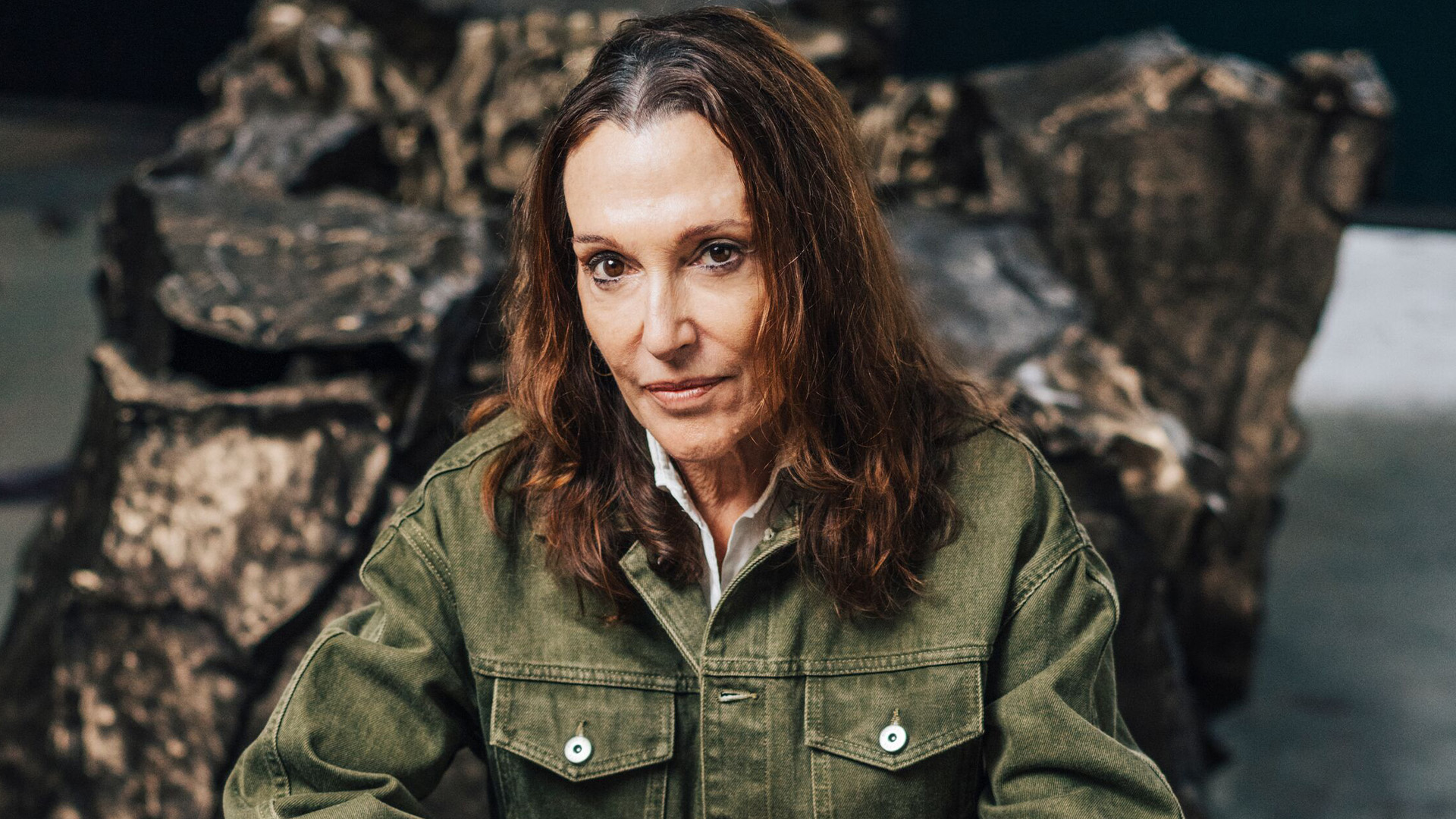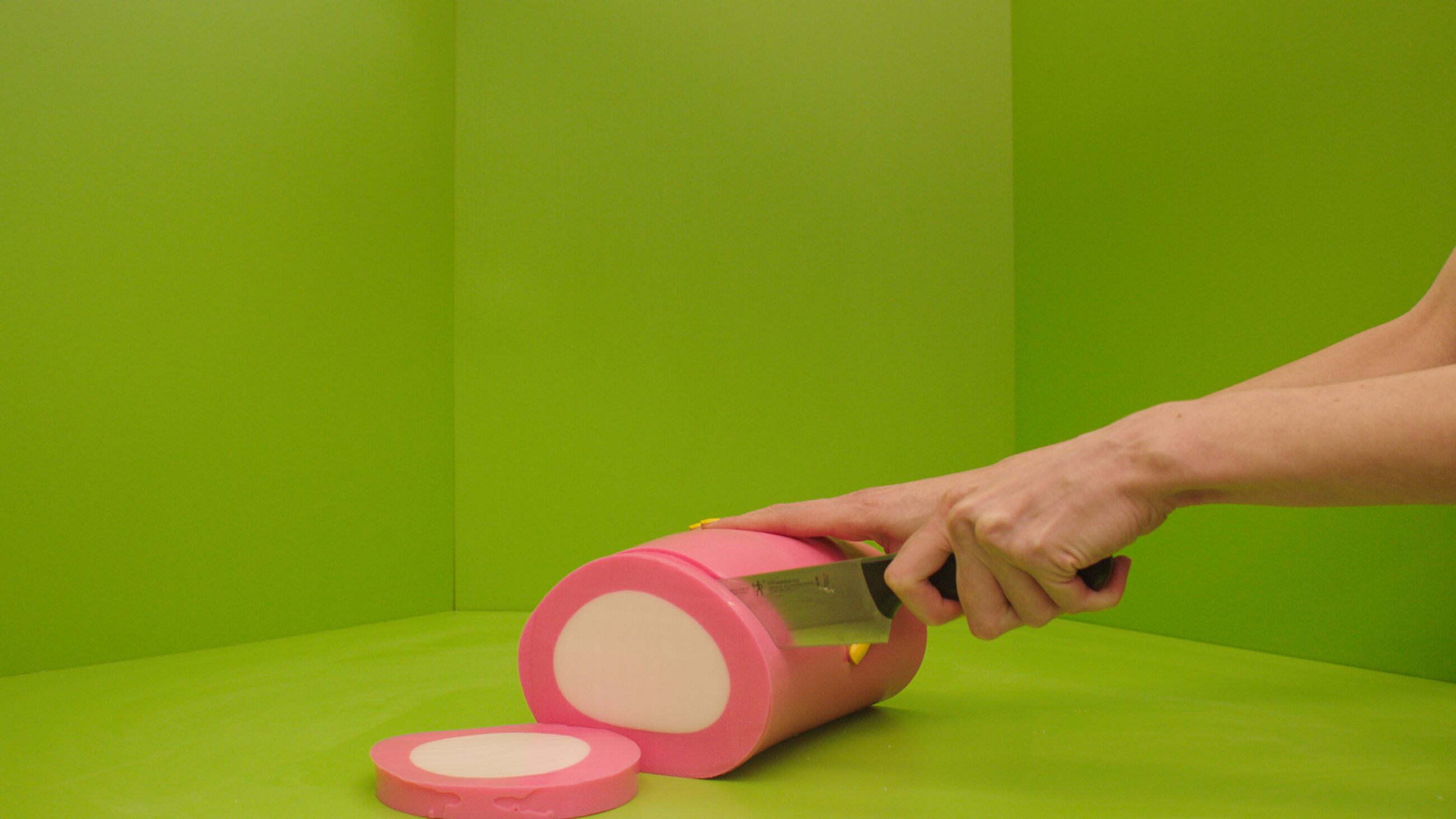Exhibition Learning Notes: ‘Mika Rottenberg. Vibrant Matter’
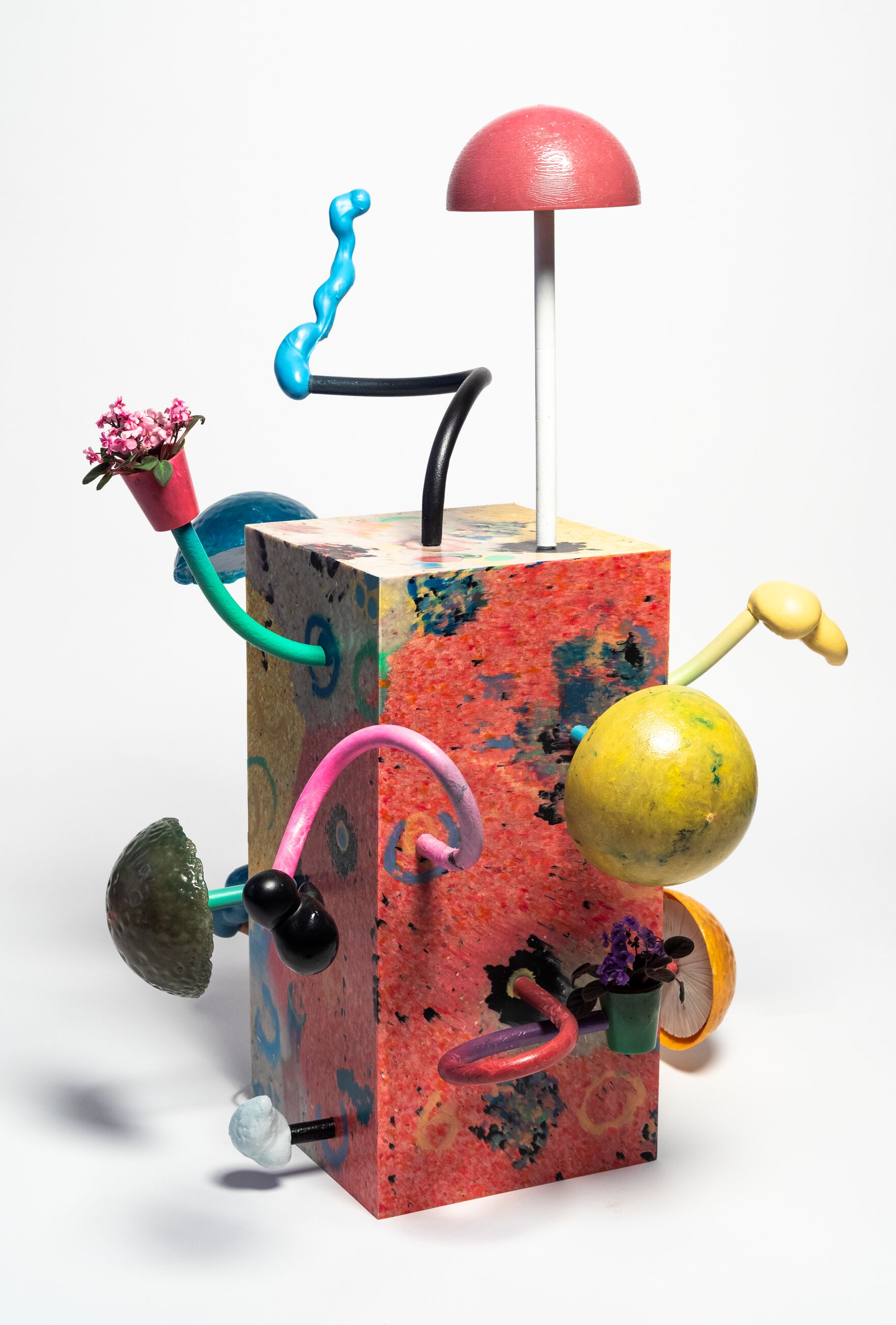
Mika Rottenberg, Lampshare (bx 1.4), 2025 © Mika Rottenberg
Exhibition Learning Notes: ‘Mika Rottenberg. Vibrant Matter’
This resource has been produced to accompany the exhibition ‘Mika Rottenberg. Vibrant Matter’ at Hauser & Wirth Menorca from 10 May – 26 October 2025.
Click here to download a PDF of this resource.
About Mika Rottenberg
Argentina-born, New York-based artist Mika Rottenberg is devoted to a rigorous practice that combines film, architectural installation, and sculpture to explore ideas of labour and the production of value in our contemporary hyper-capitalist world.
Using traditions of both cinema and sculpture, she seeks out locations around the world where specific systems of production and commerce are in place, such as a pearl factory in China, and a Calexico border town. Through the editing process, and with footage from sets built in her studio, Rottenberg connects seemingly disparate places and things to create elaborate and subversive visual narratives. By weaving fact and fiction together, she highlights the inherent beauty and absurdity of our contemporary existence.
What does the exhibition look like?
Rottenberg’s first solo exhibition in Spain presents a selection of her celebrated video installations, including ‘Cosmic Generator’ (2017) and ‘Spaghetti Blockchain’ (2019). These works are shown alongside her latest piece, ‘Lampshares’ (2024 – 2025), a sculptural installation crafted from bittersweet vines and reclaimed plastic. Additionally, a series of drawings offers further insight into her creative process, revealing the development of her surreal and thought-provoking visual language.
‘Cosmic Generator’ collapses the boundaries between fantasy and reality by bridging seemingly disconnected locations. Filmed on-site at a plastic-goods market in Yiwu, China, and at the border between Mexico and California, the work also includes studio-shot sequences and objects displaced within the installation. This blending of real spaces and magical realism distorts the viewer’s sense of place, creating a surreal experience. By intertwining fact and fiction, Rottenberg invites us to reflect on the absurdities of global trade, labour, and material excess, encouraging critical thinking about the spectacle and constraints of contemporary capitalism.
Similarly, in ‘Spaghetti Blockchain’, Mika Rottenberg creates a surreal journey through incongruous scenarios that evoke strong sensory reactions, merging vibrant ASMR performances, Siberian Tuvan throat singers, the CERN antimatter factory, and a mechanical harvester on a potato farm. The work explores the tension between the mechanical and the corporeal, demonstrating how seemingly trivial actions and objects shape our environment and social structures. Through absurd scenarios where mechanical systems take over natural processes, Rottenberg invites both fascination and discomfort. She continues to investigate materialism and the human body, using it in uncomfortable or surprising ways to examine labour, technology, and consumer goods, and highlighting how even mundane tasks can elicit pleasure or unease.
Rottenberg’s ‘Lampshares’ reimagine the artist studio as a regenerative space, transforming toxic materials into functional sculptures. Combining bittersweet vines from Upstate New York with plastic collected locally, the artist uses a custom recycling process to turn the plastic into ‘urban gemstones.’ This bespoke approach challenges the notion of cheap, mass-produced objects, highlighting the value of plastic and the labour involved in its transformation. Through these sculptures, Rottenberg explores themes of appropriation, distortion, and reinvention, reflecting on the interconnectedness of materials and the systems that bind us.
Reclaimed plastic fabrication system was developed with designer Gary Dusek. Production and design were supported by artist Garlan Miles. The plastic was sourced by Inner City Green Team Economic and Environmental Development (ICGT), led by Founder Brigitte Charlton-Vicenty. The vines were harvested and carved by artist Max Bard. The LED lights were fabricated by RUSHdesign. Production was coordinated by Natalia Sofía Almada.
The exhibition also features a selection of drawings, showcasing Mika Rottenberg’s distinct visual language. These works combine elements such as fingerprints, human limbs, and palm trees, forming a narrative where recurring motifs exponentially reproduce and eventually disappear. The drawings track the artist’s icons in a way that evokes diagrams of chain reactions and biological systems, reflecting Rottenberg’s exploration of interconnectedness and repetitive processes.
What inspires her work?
For decades, Mika Rottenberg has explored our relationship with capitalist systems of production and labour, constructing immersive, multidimensional worlds that merge the real and the surreal. Her work highlights the absurdities of global economies, using imagery that is both visually captivating and unsettling. By blending fact and fiction, and juxtaposing the natural with the artificial, she challenges viewers to reconsider their perception of reality.
Her fascination with the absurdities of global capitalism and its social and environmental consequences also informs her work. She draws inspiration from the complex systems of labour, production, and consumption, translating these into surreal, kaleidoscopic visuals. By distorting everyday reality, Rottenberg invites viewers to reconsider their relationship with material resources and economic structures.

Mika Rottenberg, Spaghetti Blockchain (Video Still), 2019 © Mika Rottenberg
How does she make her work?
Mika Rottenberg’s creative process begins with sensory experiences—sounds, smells, or physical sensations—that spark her imagination. Chance also plays a role, as conversations or online discoveries can lead to unexpected ideas. She immerses herself in hours of YouTube videos and research to develop her concepts further.
Despite being known for her work with the moving image, where Rottenberg draws on everyday objects, she started to focus on the objects themselves, and more recently, she has also been paying more attention to the environmental effects of her own productions.
‘My work is always around materials and processes, and how things come to be, this kind of combination between natural resources and people and powers to make these objects that we consume and consume us in return.’
The use of reclaimed plastic continues her interest in the exploitative process of producing ‘value’ through harnessing energies. She describes, ‘Matter, especially plastic, has a lot of trapped energy in it. I also wanted to work with materials that I could ‘mine’ and source myself.’
What are the major themes within the exhibition?
Labour & Production of value
Mika Rottenberg’s work often presents absurd and surreal scenarios that question the conditions of production and the value of labour in contemporary society. Through her distinctive approach, Rottenberg critiques the way hyper-capitalism standardizes everything—from our bodies to our emotions—reducing them to commodities that can be bought and sold. As Rottenberg defines it, hyper-capitalism is when ‘everything is standardized: your body, your mind, your smile. Everything can be sold, and everything can be perceived as something that could be sold.’ This unsettling perspective challenges our understanding of reality, highlighting the ways in which economic systems manipulate and commodify even the most personal aspects of our lives.
Objects
The artist explores the hidden narratives embedded in objects, seeing them as extensions of human minds and actions. She reflects on how ‘humankind is captured in everything around us’ and how objects carry the memory of all who have touched them. In this sense, they are not just static things but traces of labour, history, and social processes. As she notes, ‘I’m not really interested in objects. I’m more interested in the whole operation around it,’ highlighting how material goods are shaped by invisible networks of production, movement, and exchange.
Body and Consumption
She explores the body as both a personal boundary and a site of interaction with the world. ‘For me, the body is where I live. It’s the only thing I really have,’ she states, reflecting on the physical and psychological limits of human existence. Her work examines the deep connections between the body and the material world, where humans are both producers and consumers—ultimately consumed by the very systems they sustain. In her surreal and absurd scenarios, bodies merge with machines in repetitive cycles of labour, transforming human work into a mechanical force.
Sustainability
Rottenberg has transformed her studio into a regenerative factory, using discarded plastic and invasive vines to create new forms, reflecting a deep commitment to sustainability in her practice. She describes plastic as the ‘quintessential capitalist material fantasy’—endlessly malleable and always serving human desires, which makes it so appealing to capitalism. By shaping plastic, Rottenberg parallels this process with labour, giving meaning and shape to materials. Her work challenges the traditional boundaries between the ‘artificial’ and ‘natural,’ proposing a dynamic relationship shaped by human intervention. Through this, she emphasizes the need for sustainability, demonstrating how art can address ecological concerns in a world dominated by human-made materials.
Making connections with Cindy Sherman
The exhibition ‘Vibrant Matter’ by Mika Rottenberg at Hauser & Wirth Menorca are presented alongside ‘The Women’ by Cindy Sherman during the summer and autumn of 2025. In conjunction with these exhibitions, an Education Lab will explore the shared conceptual ground between the two artists.
Gender and female representation
Both Mika Rottenberg and Cindy Sherman explore identity, especially in relation to the body, gender, and social roles. Rottenberg, in her videos and installations, shows the body as a machine, shaped by work, environment, and global culture—often turning her characters into tools of production. Sherman, on the other hand, uses costumes and makeup to transform herself into different characters, showing that identity is not fixed but built through images and appearances.
Both artists use the human body as a key tool to explore representation, power, and gender stereotypes. While Rottenberg does not focus exclusively on gender, her videos often feature women with unconventional bodies and highlight power dynamics in female-dominated work environments, questioning production conditions and the value of labour, especially for women. Sherman, on the other hand, challenges female representation in media, film, and art history, using her own body as a canvas to analyse and deconstruct stereotypes.
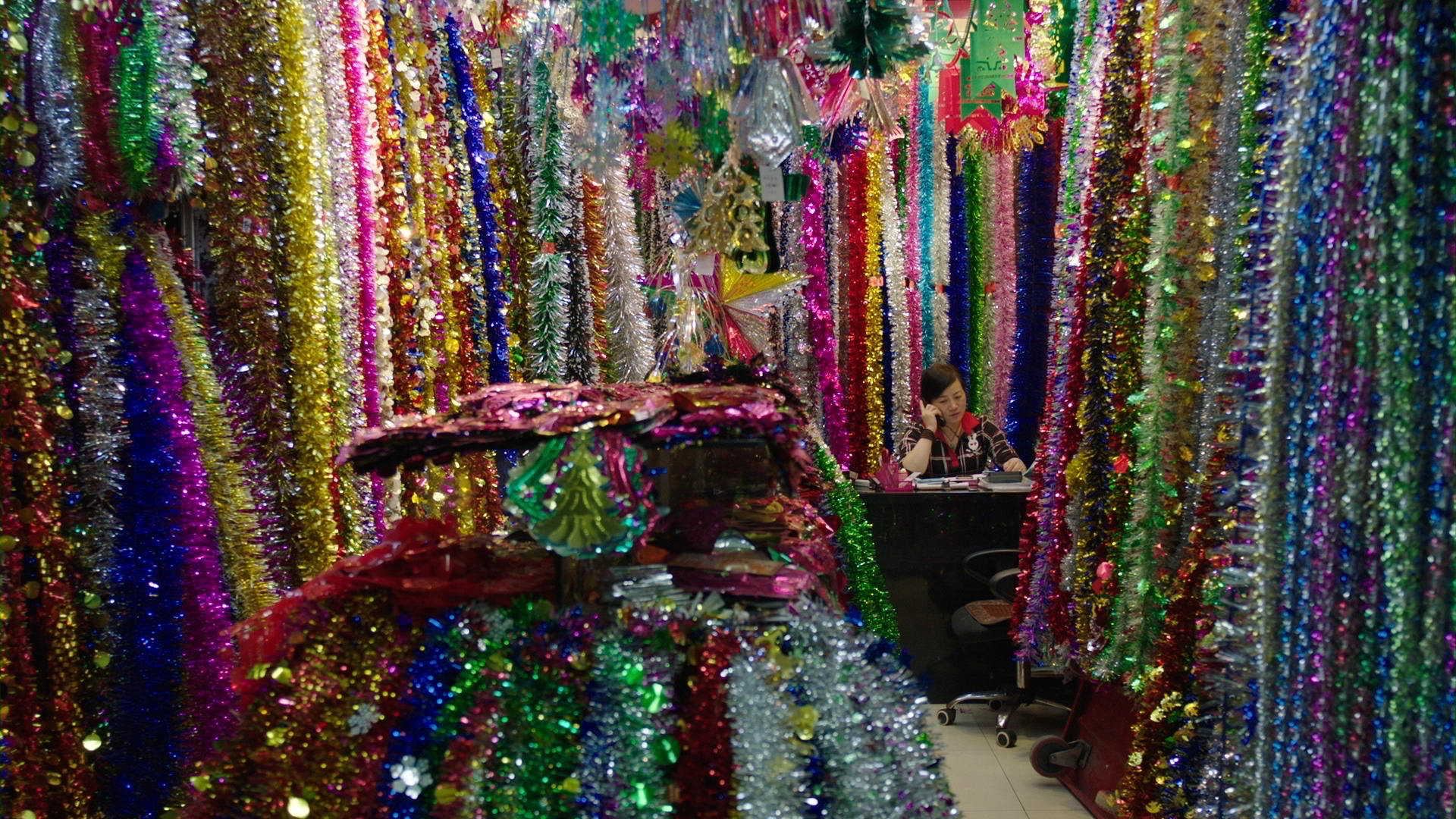
Mika Rottenberg, Cosmic Generator (Loaded #2) (Video Still), 2017 © Mika Rottenberg
Questioning of society and capitalism
Rottenberg and Sherman both question how society and capitalism affect people. Rottenberg focuses on how work can feel repetitive and dehumanizing, showing bodies as machines in a system that values production over people. Sherman, on the other hand, looks at beauty standards and social expectations, showing how the media shapes the way we see gender and identity.
Grotesque and exaggeration
Both artists use exaggeration and image manipulation to challenge the viewer’s perception. Rottenberg plays with the grotesque through humour and surrealism, creating installations with exaggerated bodies, bodily fluids, and absurd scenes that push the limits of materiality and industrial production. Sherman, on the other hand, uses costumes, prosthetics, and heavy makeup to transform herself into unsettling characters, creating exaggerated and distorted figures that challenge beauty standards and identity.
Conceptual and visual style
Mika Rottenberg and Cindy Sherman both use a strong conceptual and visual approach to explore contemporary culture, despite working in different mediums—video and installation for Rottenberg, and photography for Sherman. Rottenberg’s videos have a cinematic feel but follow a more cyclical and absurd narrative, where characters perform repetitive and surreal tasks. Sherman’s photographs also evoke cinema, with carefully staged characters and settings that look like scenes from a movie. Rottenberg plays with the grotesque through humour and surrealism, creating installations with exaggerated bodies, bodily fluids, and absurd scenes that push the limits of materiality and industrial production. Sherman, on the other hand, uses costumes, prosthetics, and heavy makeup to transform herself into unsettling characters, creating exaggerated and distorted figures that challenge beauty standards and identity.
Glossary
ASMR (Autonomous Sensory Meridian Response)
A sensory phenomenon characterized by a tingling sensation triggered by specific auditory or visual stimuli, often used for relaxation.
Capitalism
An economic and political system in which a country’s trade is controlled by private owners for profit.
Consumerism
The preoccupation of society with the acquisition and promotion of consumer goods.
Labour
The human effort, both physical and mental, used in the production of goods and services.
Materialism
A focus on the physical qualities or state of the material as integral to the art.
Recycling
Making something new out of something that has been used before.
Stereotype
An unfair generalization or a preconceived idea about a group of people.
Video installation
This term is used to refer to a type of artistic language that uses video as the main component of communication. The artist can relate this video material to other objects, materials, spaces, etc.
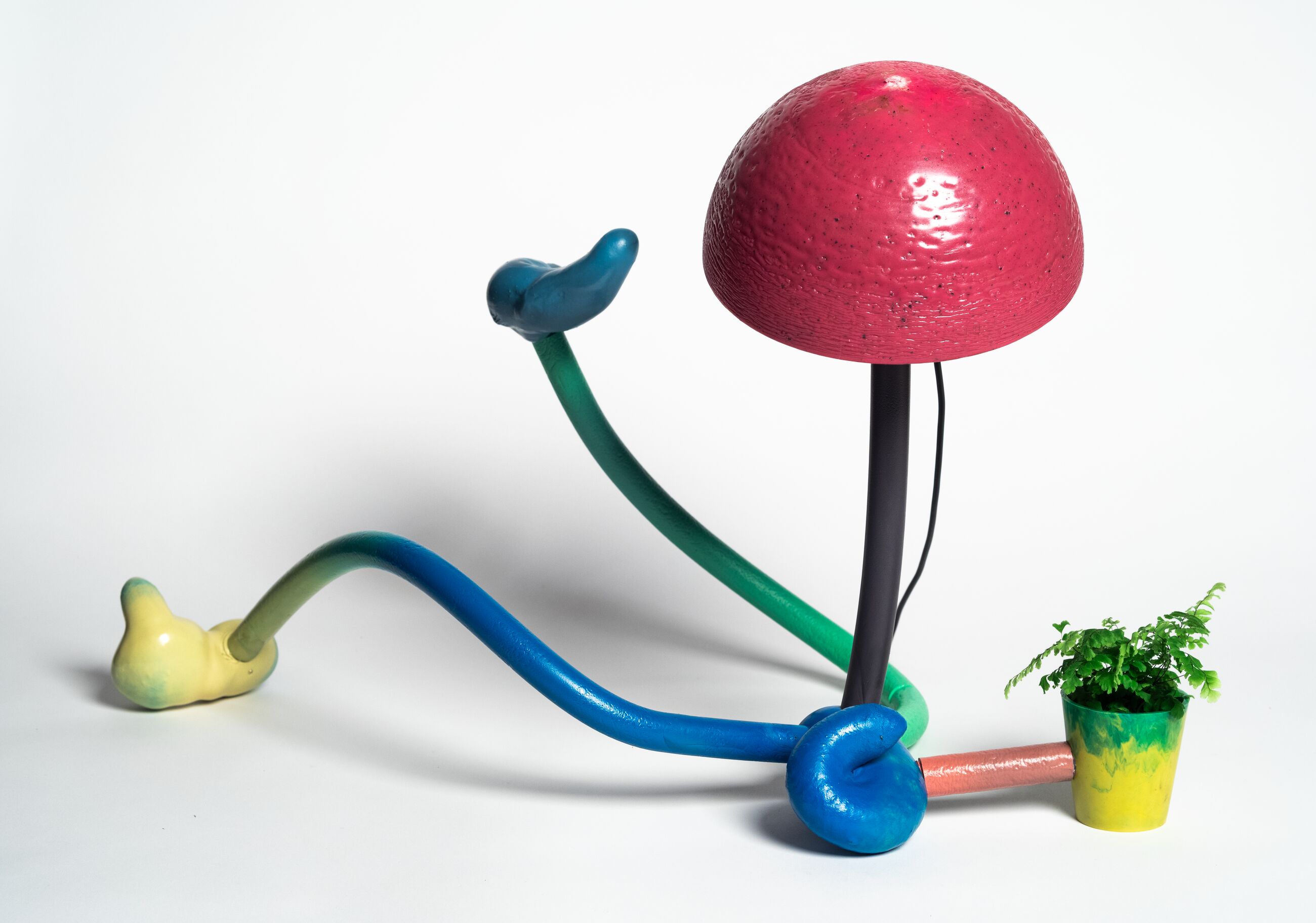
Mika Rottenberg, Lampshare (with plant 2), 2025 © Mika Rottenberg
Questions for Discussion
Take a look at the ‘Cosmic Generator’ film. Considering the five senses, what does it remind you of? A taste, a smell, a texture, a sound, and an image.
Look at Mika Rottenberg’s drawings. Do you recognize anything in the drawings? Look out for repeating elements. Is there a pattern? Are there repeated motifs? Do certain forms echo each other?
Regarding the ‘Lampshares’, what is the artwork made of? What if it were made of something else? Would it change the way you feel about it? What skills do you think is needed to create an artwork like this?
Mika Rottenberg discusses globalism and the interactions between countries. How do you think this impacts the environment and social structures? Considering your way of life, what are you most concerned about? Do you think we should address this issue individually or as a community?
Practical Activities
Using recycled materials, the students are invited to design and build a sculpture that represents Menorca’s landscape, incorporating themes of sustainability and environmental protection. Additionally, it can be proposed as a discussion topic how this landscape might change over time from a sustainability and nature conservation perspective.
According to Mika Rottenberg, ‘I believe that objects have a memory. Every object has a story—the story of all the people who have touched it. They are an extension of minds and actions.’ We invite you to choose an object and create a timeline to visualize its journey and all the hands it has passed through before reaching yours. You can also imagine what might happen to this object in the future, all the way to its decomposition (if possible).
Collecting the sensations of everyday actions. We invite you to make a list of daily actions that you repeat every day (e.g., opening and closing a zipper, sweeping, writing with a pencil, sneezing, cutting vegetables, etc.). In groups, you can record the sounds and images of these actions (10–20 seconds). Finally, you can edit all the clips into a single ASMR video. To conclude, reflect on the experience: What brings us the most pleasure? What feels more unpleasant? Can certain sounds make us uncomfortable? Do you think everyday sounds can influence our mood without us realizing it?
Supplementary Research
Resources
1 / 10

